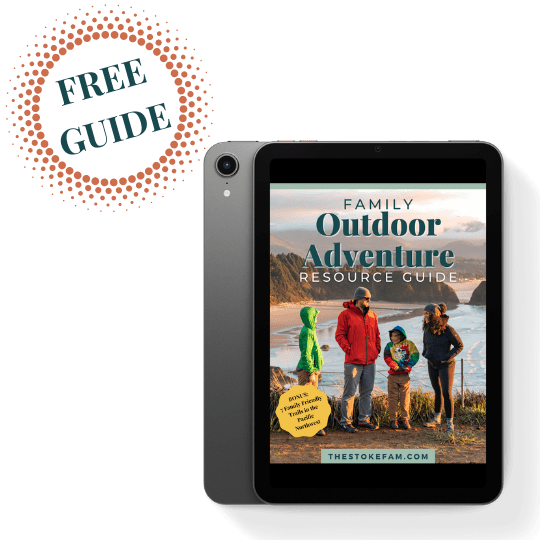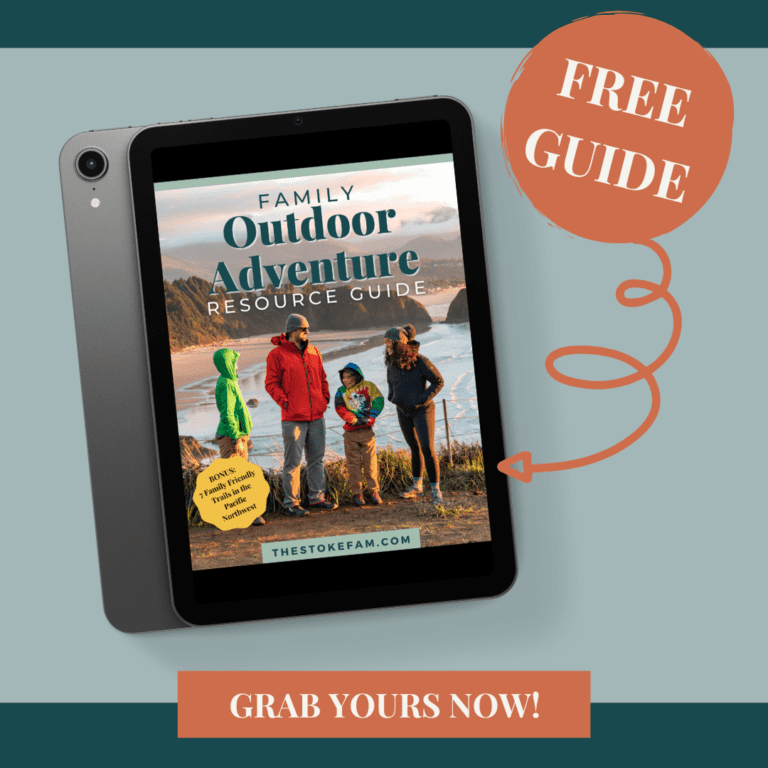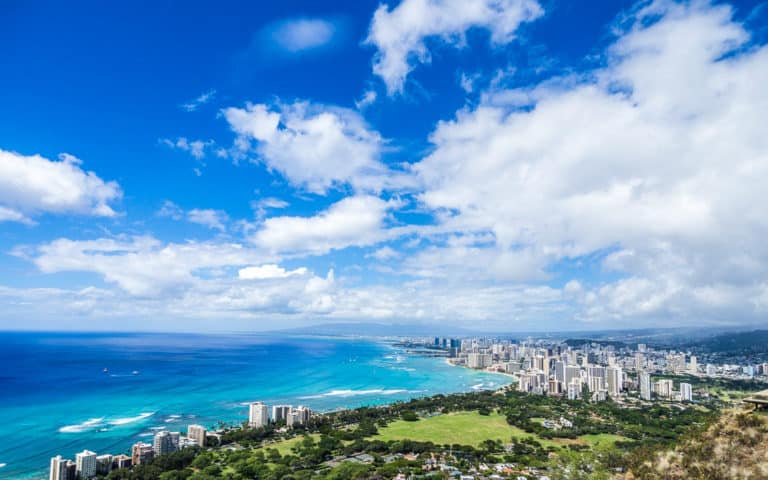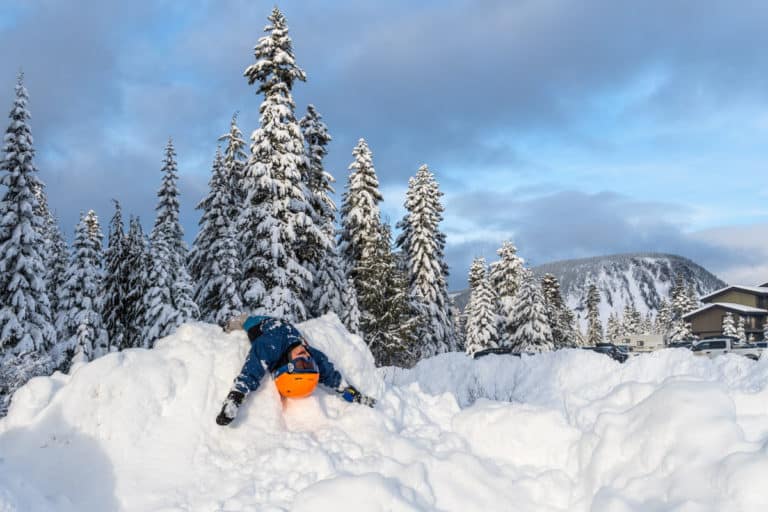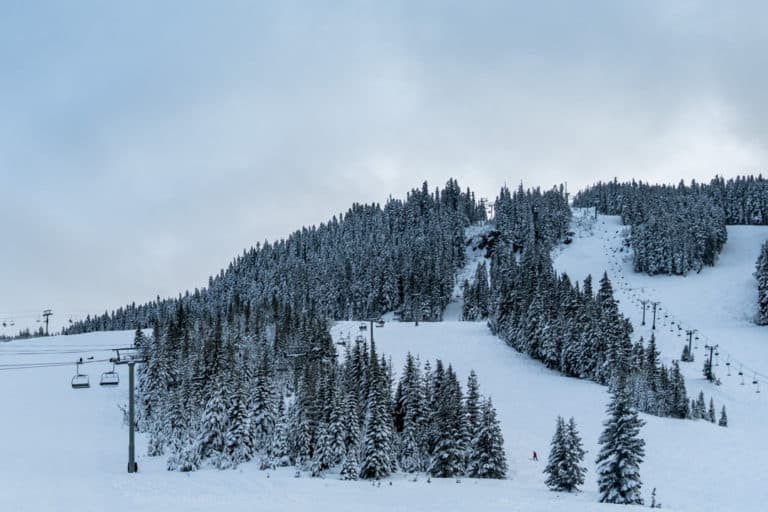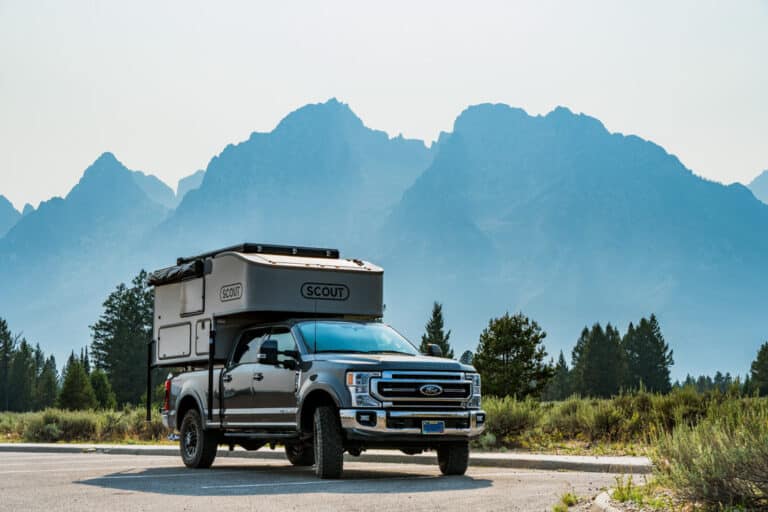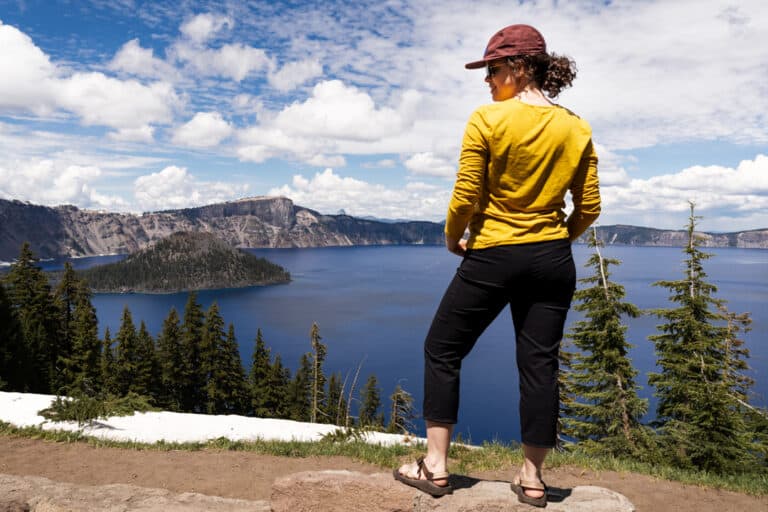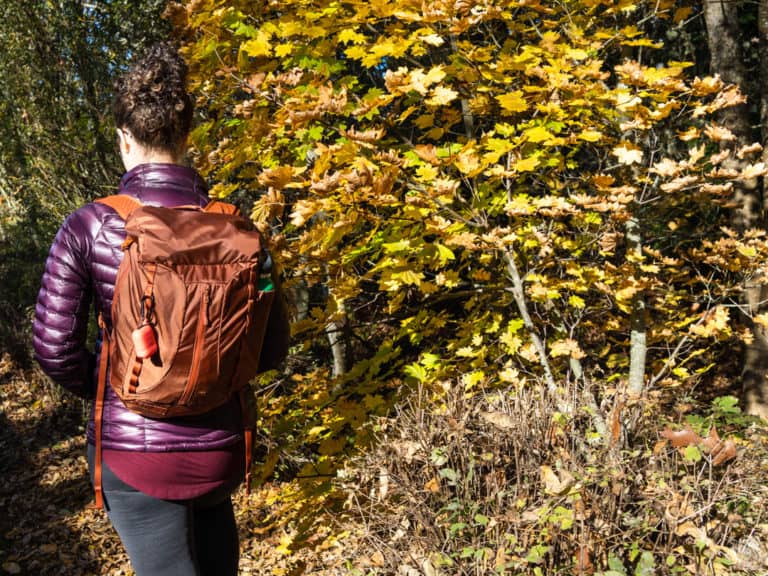When you’re planning what to bring on a hike, sometimes it can feel overwhelming.
You want to be prepared, but you also don’t want to carry 50 pounds on your back when you know you’ll likely end up carrying a tiny human at some point as well. 😬
So, what do you really need to take on a day hike?
Spoiler alert: That super handy ax might be handy if you ever need to chop a tree to make a fire, but you probably can find a more lightweight option to provide some warmth. And, probably leave less of an impact on the forest while you’re at it. 😉
When you’re heading out on the trail, there are certain hiking essentials you need to take with you every time.
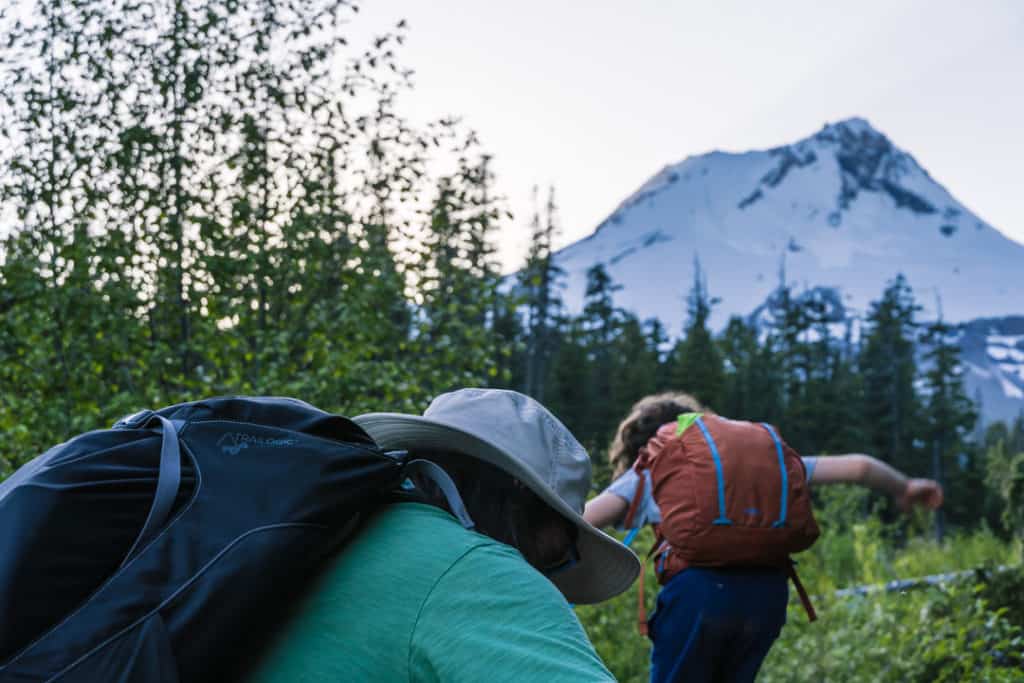
Ready to get right into the details? Click here to jump right in or use the table of contents above.
Otherwise, settle in for a quick minute while I tell you a little story about the importance of packing the right gear on a hike.
Have you ever tried convincing a tired, hungry, thirsty toddler that they have to wait for food or a drink? I have.
0/5 Stars. Do NOT recommend. 😬
Years ago, we set out on a day hike when my oldest was about a year and a half old. I was pregnant with our youngest, and we were with a friend and her daughter (also about a year old).
We chose a relatively easy trail, and had all the essentials we needed for our hike – or so we thought.
However, the hike that day wasn’t what we expected. A trail marker was missing, which ended up costing us valuable time (this was in the early iPhone days, prior to fancy GPS apps and lightweight portable chargers). We had a paper map, but it took a lot longer to realize our first mistake than it would have today.
The sun was going down quickly, and it became immediately apparent that we were NOT prepared to spend the night in the woods (mistake #2). But, we really had no idea how long it would take us to backtrack and finish the right trail back to our car.
We also had not told anyone exactly where we were hiking. ←Mistake #3
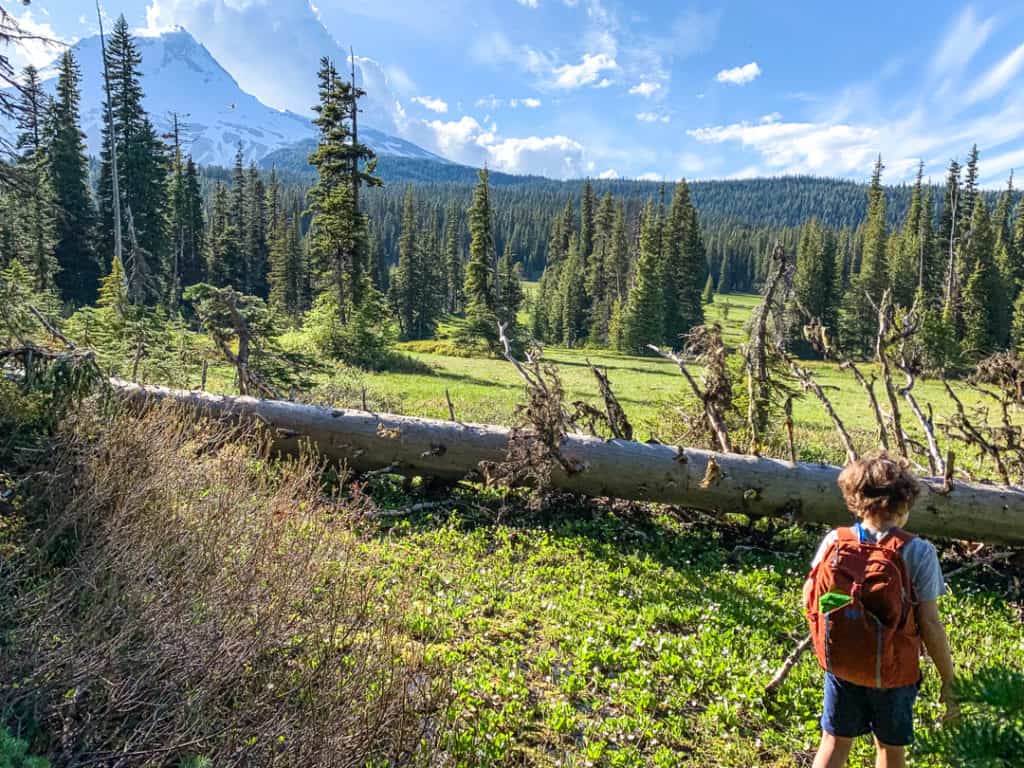
And, then, we came to the spot where we were supposed to cross the river…and there was no bridge.
No log to balance on as we tried not to fall in with toddlers on our backs. No rocks to step on either.
We walked up and down the river bank for a bit, trying to see if there was another crossing we had missed. There was not.
By this point, it was dusk, and the temperature was dropping. And the river water was COLD.
You know how you know when things are getting really serious? Everyone gets silent and stuck in their own thoughts. Processing. Thinking. Strategizing.
That’s precisely what was happening as we stared at that river, trying to decide what to do.
Complete silence.
We all knew how terrible this could end up if we weren’t smart. And we were suddenly incredibly aware of how unprepared we really were.
This was the moment we realized that whether you’re heading out on a short family hike or planning an epic full-day adventure, you must have the right gear. Because, if you don’t have the right hiking equipment, you may find yourself in a situation that is uncomfortable at best – and downright dangerous at worst.
I don’t share this to freak you out, but to remind you that even when a hike seems straightforward, it’s always a good idea to be prepared in case of an emergency. And, don’t worry. I promise to share the rest of the story before I wrap things up.
Below, we discuss the standard “10 Essentials” for hiking, our suggestions and thoughts on specific gear, as well as items that are nice to have – and what you probably should leave at home. Whether you’re heading out on a short hike or are planning longer day hikes, you’ll learn exactly what to add to your gear list.
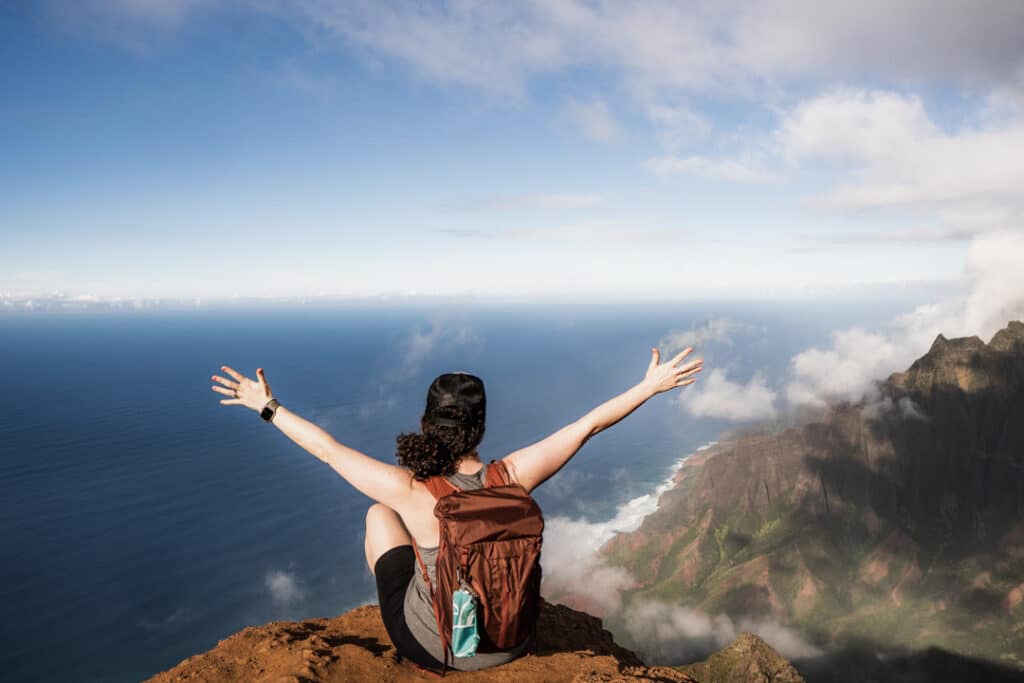
10 Essentials (a.k.a. Hiking Equipment Must-Haves)
The Ten Essentials are a list of things to bring when hiking, each and every time. When deciding what things to bring on a hike, they are absolutely the most important items and will help you be prepared for many different scenarios.
When I was writing this post, I was curious where the 10 Essentials originated and who came up with the original list. So, I did a little digging. According to both REI and Wikipedia , The Mountaineers organization (based out of Seattle) was the first to create the list. The goal of The Ten Essentials is to make sure that people are prepared for emergencies that can occur during outdoor adventures. It originally dates back to the 1930s, but they wrote up the official list that we’re familiar with now in 1974 in Mountaineering: The Freedom of the Hills.
In addition to this list, it’s also important to note that it’s always a good idea to also let someone know where you’re going and when you expect to be back. That way, if something does go wrong, you’re prepared to deal with it (because you have all your hiking necessities).
Still, you’ll also have someone who can call in backup if you don’t return when you are supposed to. You can use tools like the Garmin inReach Mini 2 or AllTrails+ Lifeline for extra peace of mind.
1) Navigation Items
One of the most important things to have on a hike is a way to navigate on your chosen hiking trail. There are several ways you can do this. Whichever way you choose to navigate your hikes, it’s usually a good idea to have a backup as well.
We typically use a GPS app (Gaia GPS) on our phones. However, it’s always a good idea to carry a paper map as a backup, along with a compass.
If we can, we prefer to have waterproof physical maps, but, if we don’t have a one for our area, a printed paper map tucked in a ziplock bag also works to keep it dry – just in case.
One thing to note is if you’re relying on your cell phone as your GPS, you’ll want to make sure that you have a fully charged battery and you may also want to carry a portable battery charger.
For extra peace of mind on outdoor adventures, the Garmin inReach Mini 2 is a great choice. Use it for two-way communication and to send an SOS in an emergency.
2) Sun protection
A lot of the hiking we do is in the woods under cover of trees for large parts of the day. But, it’s crazy how quickly you can find yourself burnt after taking a break by a stream or lake.
We always carry sunscreen with us, but we also try to make sure that everyone also has a hat, sun shirt, and/or sunglasses with them. It’s a huge help to protect your eyes from the brightness and UV rays.
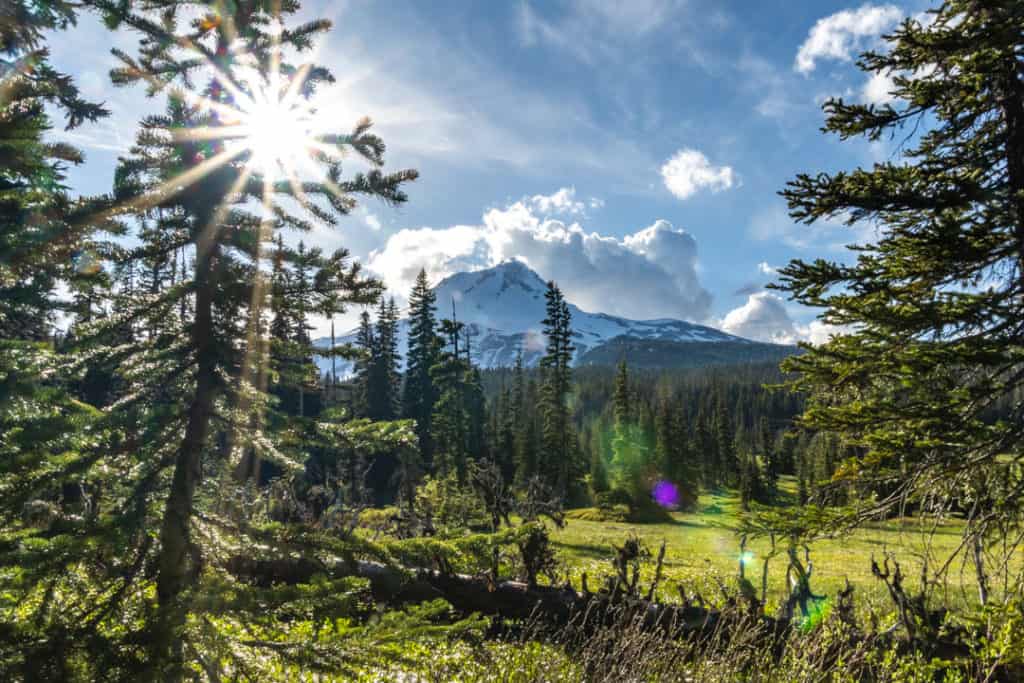
3) Insulation/Warmth
Even if you’re heading out in warmer weather, it’s typically a good idea to bring an extra layer or two. You never know when weather patterns will change, and it’s always better to be prepared for rain, a dip in temperature, or the possibility of needing to spend a night outdoors.
It’s also a good idea to take a waterproof or water-resistant outer layer and warm mid-layer (such as a down puffy or warm fleece) at the minimum. During winter hikes or when hiking at elevation, we often add base layers as well.
- Rain jacket and/or pants
- Puffy jacket or warm (non-cotton) layer
- Extra top and bottom layers that will dry quickly
- Warm hat and gloves
4) Lighting or Illumination Source
If you happen to find yourself in an area without natural lighting or out at night, you will want some sort of light source to help you navigate and find your way. A headlamp is our favorite option because it leaves our hands free.
- Headlamp, flashlight, and/or lantern
- Extra batteries
We're huge fans of our Black Diamond headlamps and this model is one of our top picks because it includes dimming and a red light function. Plus, you have the option of using alkaline OR rechargeable batteries.
5) First Aid Items
Having a first aid kit when you are out can help in an injury or emergency. You can start with a basic first aid kit and adjust it to fit your activities, the medical needs of the group, and the length of your trip. We have this one that is for up to 4 people for up to 7 days and has a few extras too. If you do a lot of longer hikes into the backcountry as well, you might prefer a more extensive kit like this one. Or, you could totally make your own from scratch.
You can also opt to put together your own first aid kit. Here are some of the most important items you’ll want to include:
- Bandages in various sizes, including butterfly
- Antibacterial ointment
- Headache/pain medicine – make sure to include children’s versions if hiking with kids
- Gauze and medical tape
- Tweezers
- Antiseptic wipes
- Insect sting treatment
- Moleskin or blister patches
- Antihistamine (such as diphenhydramine)
- It’s always a good idea to include an instruction card on how to use items and/or a wilderness first aid booklet as well.
- Any crucial emergency or prescription medications you may need during your hike or if you were out overnight, such as an epinephrine autoinjector or insulin.
For a more complete first aid kit, you can also add additional items that could come in handy in an emergency situation.
- Splints, elastic wraps, cleansing pads, liquid bandage, non-stick dressing, etc
- Eye drops additional pain medications such as aspirin, poison ivy treatment, prescriptions, epinephrine, Immodium, antacids, etc.
- Multitool or pocket knife, cotton swabs, thermometer, syringe, scissors, gloves, CPR mask, notebook/pen, oximeter, electrolyte packets for rehydration, etc.
- Lip balm, bug spray, feminine hygiene products, aloe vera
6) Fire
If you happen to find yourself in an emergency, having a fire source could be the key to saving your life. Fire can create warmth, a source for cooking, and can also be a signal to help you get found. Think how much more comfortable we would have been with a proper fire starter kit when we got lost!
A few options to consider include:
Note: Before heading out, make sure you know the current fire restrictions in the area you’re hiking so you can plan accordingly for alternate heating and fuel sources.
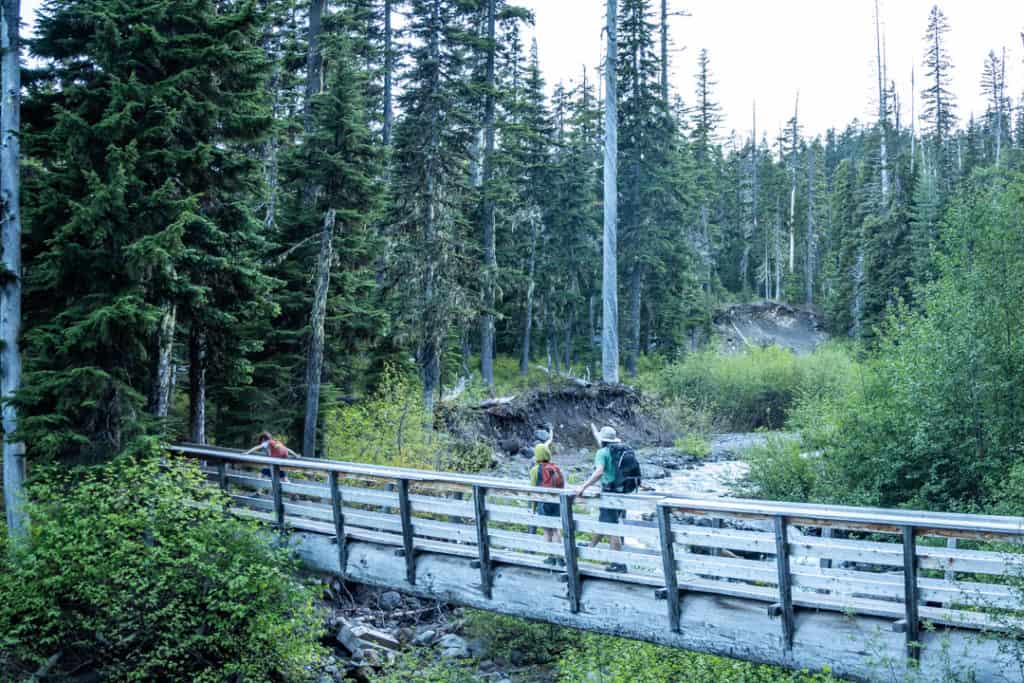
7) Tools/Repair Kit
I’ve seen or experienced a variety of issues on the trail that require repairs, including soles coming apart from hiking shoes and jackets or pants getting torn. You can fix many issues that can arise on the trail with just a few basic tools and supplies, without adding much weight.
- Multitool and/or knife
- Duct tape
- Paracord
- and/or Gear Repair Kit
Tip: To save space and weight, wrap duct tape around your water bottle or under the handle on your trekking pole.
8) Food and Nutrition
Having proper nutrition is definitely important, and you should always hike with additional food. Ideally, you’d want food that could last up to an extra day, just in case of a change of plans. Things that are lightweight and high in nutritional value are most beneficial – think granola bars and trail mix over chips or items that need to be refrigerated.
- Food and snacks for the duration of your trip
- Food and snacks for an extra day
Need some food ideas for your hikes? Check out these ideas for easy-to-carry snacks or lunches and this article on trail snacks (also known as “pocket snacks” in our house).
9) Water and Hydration
I know this one seems so obvious.
But, remember that hike? We were down to our last 16 oz bottle of water when we realized we were lost. For 5 people. It was not fun. We did not have any way to purify water with us at the time. Now, we always carry more water than we think we need, plus a water filter or other purification option, even on short day hikes.af
Staying hydrated can obviously mean the difference between life and death. So, make sure to account for the additional water you may need, taking the weather forecast into account.
It’s also a good idea to know where water sources are along your hike in case you need to refill. Do keep in mind, if you are obtaining water from a natural body of water, you will want to have a way to purify your water with you.
- Water bottle and/or hydration bladder (this is my favorite)
- Water filter or other water treatment method
Even when we're heading out on a day hike, we like to take a water filter with us just in case. These compact water filter straws from LifeStraw are the perfect size to add to your pack as an extra layer of safety on day hikes or for backup filtration on longer trips.
10) Basic Shelter for an Emergency
If, by some chance, you end up getting stuck outside overnight or during severe weather, having a shelter that can help to protect you from the elements can be crucial. There are several options that you can use to accomplish this goal, including lightweight options that are perfect for bringing on a day hike. A few choices are:
Day Hike Essentials
But, there’s more than just the hiking must-haves above. While some of these are optional, most of them we consider part of our day hike essentials because they make the hiking experience so much better.
Backpack
One of the first things you’ll need when you’ve collected your Ten Essentials is a backpack to carry them in. Our favorites are options with a pocket for your hydration pack. Here are a few options we recommend:
- Mountain Hardwear Scrambler
- WANDRD VEER: This one is great because it also converts well for a travel backpack. I will say if you’re going to carry a very heavy load though, you may want one of their other options, like their new FERNWEH, which I’m dying to get my hands on! If you want to know more, click to read our full review of the WANDRD VEER.
- Osprey Sirrus 24 Women’s Hiking Backpack or the Men’s Version of the Osprey
- Gregory is another great brand for hiking backpacks so I’d also recommend one of these options.
Trash Bag
One thing that we find incredibly useful to take with us is a trash bag or gallon zip top food storage bag. It’s perfect for our own trash – like FBOMB packets that can ooze a bit if you put them in your backpack after eating. Ask me how I know. 😬
So, we take a bag to be able to carry out our trash with a little mess. However, the other reason we carry a trash bag is to be able to pick up any trash that we may find along the trail. More often than not, during our hikes, we often find at least a few items that were dropped or forgotten or sometimes purposely left…😡
(It’s also a good idea to toss in gloves and/or hand sanitizer for picking up anyone else’s trash.)
Insect Repellent
In my opinion, bug spray should really be the 11th Essential. 😅 I’m a mosquito magnet, so I never hike without it, especially during early summer, near bodies of water, or through alpine meadows.
And for the handful of inevitable bites, I LOVE the Bite Away for reducing itch after the fact.
I found out about bite away a couple of years ago and it goes on every hike and vacation with us now. It works to reduce itch from insect bites by heating up (it's warm, but not scalding hot) to trigger a natural response from your body to make those pesky bites less annoying.
Even my 11-year-old uses and loves it!
Treats (a.k.a. Motivational Snacks)
You wanna know what will motivate a 6-year-old to make it the last ¼ mile to the end of your hike? It’s definitely not baby carrots or raw broccoli.
We recommend Skittles. Or Nerds.
Look, we really try to be as healthy as possible. Most of the time.
But, we also think it’s all about balance. And, if our kids (or us – don’t judge!) need a little motivation to get to the end of our hike, I’m totally okay with that.
No matter what your treat of choice is, it’s amazing what a little bribery motivation can do when everyone’s legs are getting tired.
GPS/Signaling Device
One thing we always like to take with us is some sort of GPS, as we mentioned above. It’s typically our phone with a hiking app (Gaia GPS is excellent for this).
However, we recently added a Garmin inReach Mini 2 to our hiking gear. It works even when you’re out of cell service range to send emergency messages and alert search and rescue if needed.
For extra peace of mind on outdoor adventures, the Garmin inReach Mini 2 is a great choice. Use it for two-way communication and to send an SOS in an emergency.
Another alternative, with some caveats as it still needs a data signal but is great for hikes where you maintain coverage, is the AllTrails+ Lifeline feature.
Bathroom Supplies
For day hikes, it’s always our goal to have everyone do their serious business before leaving the house. But, no matter what, we’re all going to have to pee in the woods at some point. And, it’s always a good idea to be prepared if you have to poop as well – just be sure to follow local guidelines and Leave no Trace principles. Our typical bathroom supplies for a day hike include:
- Small roll of biodegradable toilet paper. Though, our plan is always to pack it out anyway.
- Sealable plastic bag for toilet paper (or feminine waste products)
- Trowel
- The Tinkle Belle. Since I’m the only girl in the family, this one is only for me, but it is essentially a pee funnel that allows you to pee standing up. I love it because I don’t have to drop my pants to the ground while looking over my shoulder to make sure no one is coming.
- A Kula cloth is another great option for wiping (pee only) on the trail
Lightweight Microfiber Towel
Lately, I’ve gone to adding a small camping microfiber towel to our day pack. It’s come in handy in multiple situations: drying feet after wading in the river, wiping rain sprinkles off glasses, a place to sit, etc.
Portable Phone Charger
When you’re relying on your phone for navigation, you may want to add a portable charger to your list of things to bring when hiking. Ideally, choose something lightweight and/or solar-powered. This is a good option that is relatively small and easy to carry.
Footwear
When you’re heading out on a hike, you’ll want a good pair of comfortable hiking shoes. Whether you opt for trail runners or sturdy hiking boots is somewhat personal preference, but you should also consider the terrain and length of your hike when making your choice.
Here are some of my favorite hiking shoes:
The sole on the Altra Lone Peak is one of my favorites of any hiking shoe. It's grippy without being stiff and holds up well in dry or wet weather.
These hiking shoes from Oboz are some of my favorites! They have excellent arch support, sturdy lugs on the sole for a variety of terrain, and were comfortable right off the bat.
These closed-toe water sandals are great for short hikes in the summer - especially those with water crossings!
In addition to shoes, having a good pair of hiking socks is also key. My favorite are merino wool socks from Darn Tough. They are durable and breathable, and have a variety of options to suit any time of year.
I love that Darn Tough socks come in a wide variety of styles and weights for adventuring in different conditions. These lightweight crew socks are my go-to choice with my Oboz hiking boots for most hikes in fall, winter, and spring.
Trekking Poles
If you don’t have trekking poles, you can often find a stick that can serve as a walking stick, but a set of poles is definitely nice to have. I have the set below and have been very happy with them overall.
These lightweight hiking poles from Leki telescope down into a small package that's easy to carry when not in use. They adjust from 90cm up to 125cm to accommodate different heights and have ergonomic handles for comfort.
Additional Items to Add to Your Hiking Packing List
- License/ID
- Permit/access pass for the area you will be hiking in
- Lip balm
- Extra pair of wool socks (wet socks can cause blisters)
- Dry bag and/or rain fly to keep your essentials dry in a rainstorm
- Camera
- Plates/utensils/stove if you plan on cooking during your hike
- If you’re hiking with a pet, you’ll also want to include water for them, a bowl or way to let them drink, treats or food, a leash, dog bags, and perhaps a jacket if they are prone to getting cold.
- Extra pair of shoes in the car to change into after your hike
- Hat
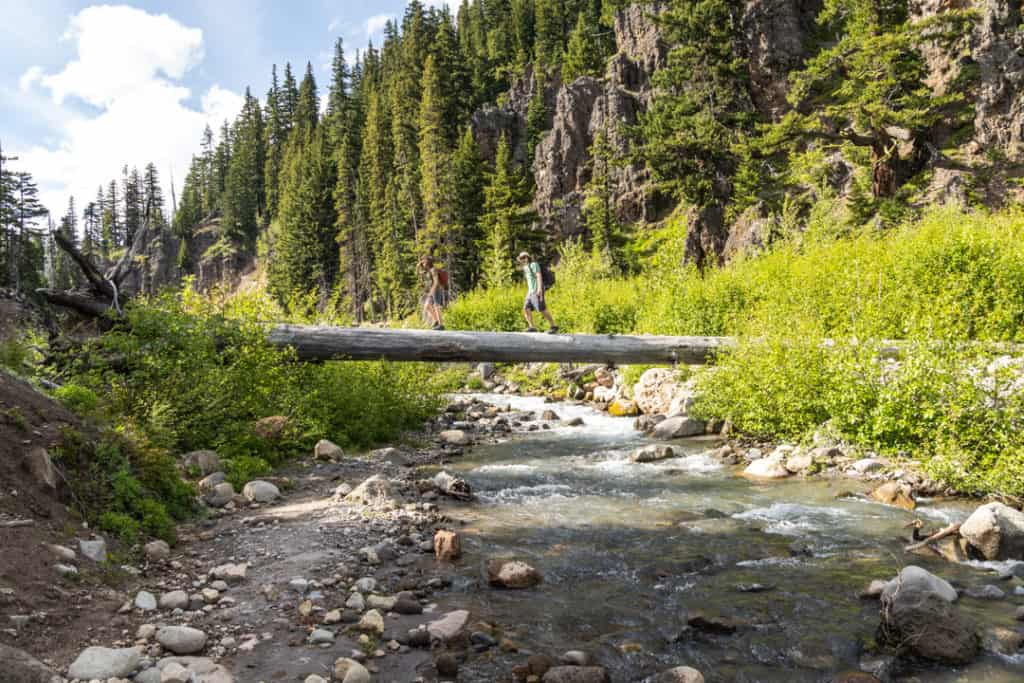
Things You Should (Probably) Leave at Home When You Go Hiking
When narrowing down your list of what to bring on a day hike, there are a few things you can leave at home.
Serious/Hefty Tools
Of course, there might be that instance that an ax or hammer comes in handy, but for us? The chances of needing them aren’t high enough for us to carry the weight.
Instead, we take a good multitool or knife and have an alternate plan for an emergency shelter.
Jeans
I’m sure I’m guilty of hiking in jeans at some point, but it’s not likely you’ll ever find me doing it again. They are much heavier, restrict your movement more, and if they happen to get wet, they will stick to you and stay wet forever.
If they are all you have and the temps are supposed to be mild, you may decide to deal. But, even if you have a pair of workout pants or leggings, you will probably be a lot more comfortable due to the wicking and breathability factors. In fact, if I’m not wearing hiking pants, leggings are my second choice.
These Prana Halle Pants are some of my absolute favorite hiking pants and John loves the Prana Zion. They repel water, are lightweight and breathable, stretch and move with me, roll up if I get too hot, and dry SO fast. Plus, they are a little more fashionable than some hiking pants do. 😉
Cotton Clothing
Don’t get me wrong, I love cotton. And, I’ve totally been known to wear a cotton tank or t-shirt on a hike. But, if I do, I’ll also have another option in my pack that is not cotton.
In general, there are much better materials for hiking clothing. If you happen to get wet and cold in cotton, it’s going to stick to you and make you even colder.
Merino wool and synthetic materials will wick moisture away from you and dry much faster, making it much easier to regulate your body temp. So, whenever you can, we recommend choosing these options.
Too Many Extra Gadgets
Yes, the family who often carries a camera, chargers, and sometimes a drone is the one telling you this, lol! But, those aren’t really what we’re talking about.
We’re talking more about iPads, portable speakers, portable gaming systems, etc. It’s not worth the weight on your average day hike, in my opinion. The views and soundtrack of nature are better anyway. 😉
Printable Day Hike Checklist
The last thing you want to do when you’re packing all the essential gear for a day hike is to forget any of the must-haves and find yourself in an uncomfortable (or worse – dangerous) situation.
We don’t want you to have an experience like our hike years ago. So, we made this quick one-page day hike checklist for you – no more wondering what to bring on a hike!
Just grab yourself a copy here and print it out so you can always be sure you have exactly what you need for your next hike. You can even laminate it to make it reusable and waterproof!
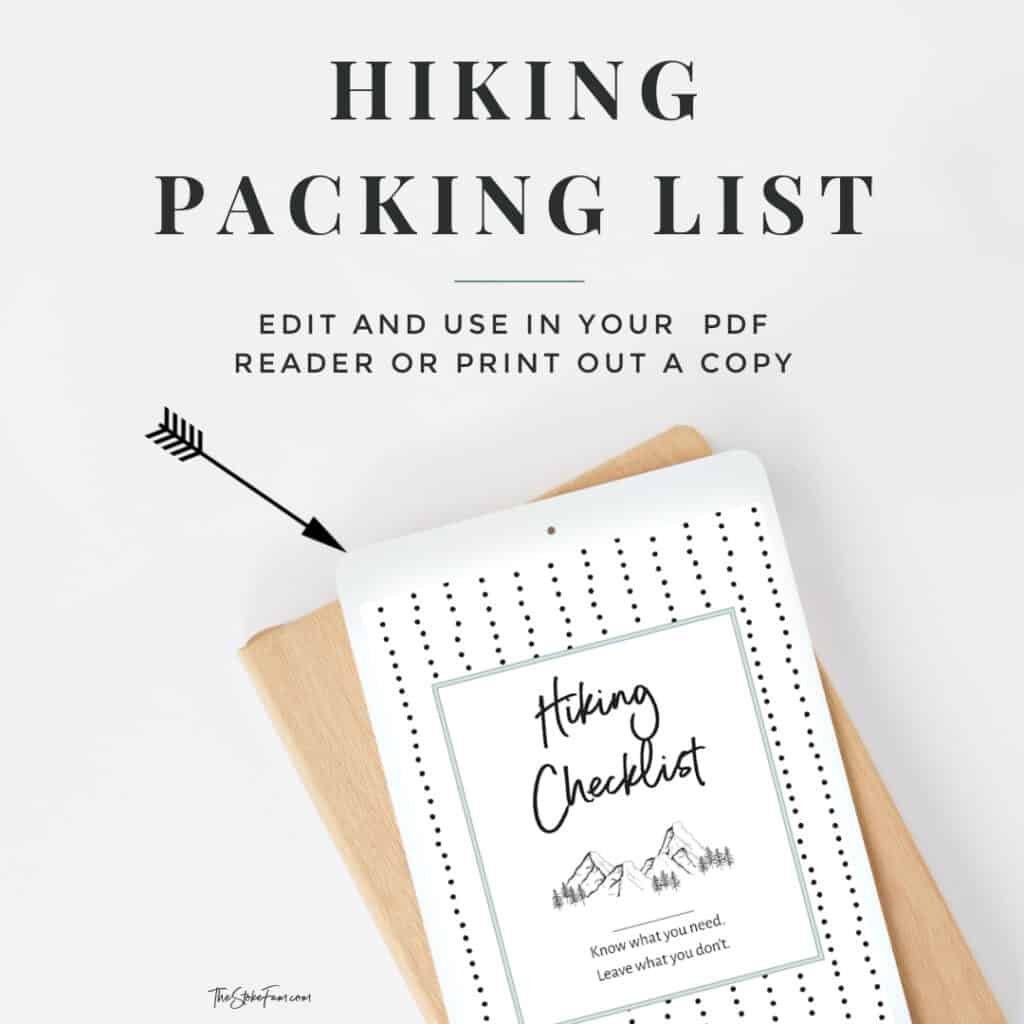
What to Bring Hiking: The Rest of the Story
Back to that day hike that could have been disastrous…
Eventually, we decided that we needed to cross the river based on the trail map we had for the shortest distance back to the car.
Our map, mind you, was on our old iPhone. And, all three adults were dangerously low on battery power, and we had no backup (mistake #4). Which we were now using for navigation AND a flashlight since we had failed to bring one (mistake #5).
We removed our socks and shoes, rolled our pants up as high as possible, and carried our toddlers across the river through frigid water that was a few feet deep.
After trying to dry out as much as possible – I don’t even remember what we used, probably a burp cloth or baby blanket if I had to make a guess – we put our shoes back on and continued on the trail.
As we crested a hill, we finally got a weak cell signal. Our friend, who was with us, was able to reach her husband and tell him where we were. We thought we were on the right path, so we set a time that he should send help if we hadn’t made contact.
We literally made it to the car with 5 minutes to spare before our designated “send help” time.
Let me tell you, it was NOT a fun day, but it was probably one of the most valuable experiences we’ve ever had. Getting lost in the woods with two toddlers (while pregnant) and not enough supplies is something I never want to revisit.
It taught us that we must be more prepared. It taught us that even an “easy” trail can turn dangerous if you don’t know exactly what to take hiking.
But, we’re incredibly thankful that we made it out safely and didn’t end up spending the entire night hunkered down.
Have you ever had any close calls on a day hike?


